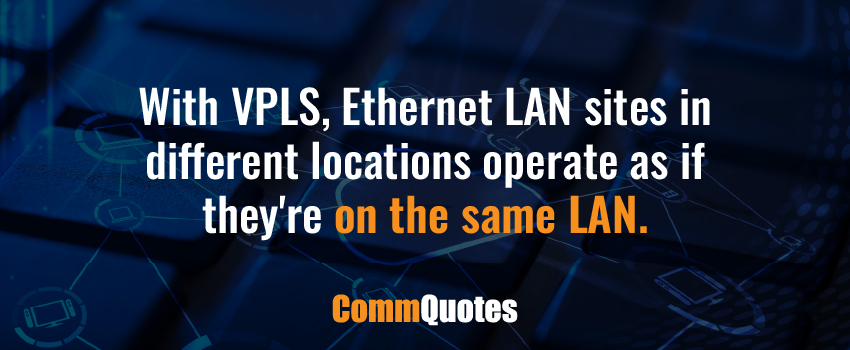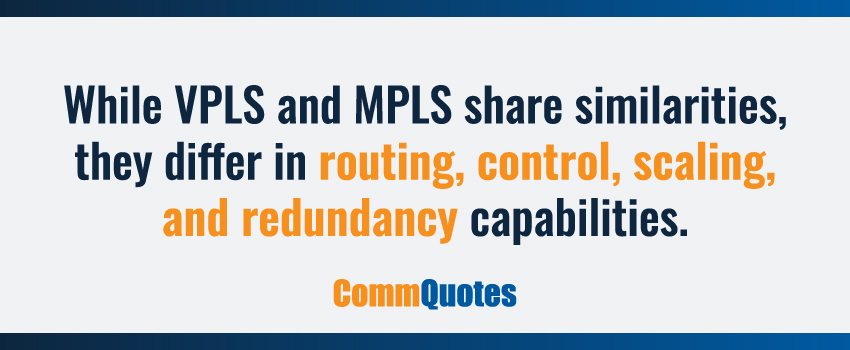Connectivity is the backbone of successful business operations in today’s digital world. From facilitating seamless communication and collaboration across global offices to enabling cloud computing and remote network access, multi-site networking solutions like virtual private LAN service (VPLS) are essential for businesses to compete effectively.
The VPLS market is estimated to reach $2.5 billion by 2026,1 with more organizations turning to this networking solution to integrate branch offices and data centers for flexible, scalable, and efficient networks that can support their digital transformation goals. In this blog, we’ll explain how VPLS works and how it can help your multi-location business grow.
What Is VPLS?
VPLS is an Ethernet-based point-to-multipoint Layer 2 virtual private network (VPN) that enables businesses to connect their geographically dispersed sites across a shared multiprotocol label switching (MPLS) backbone. With VPLS, Ethernet LAN sites located in different places appear as if they are on the same LAN, even though traffic travels across the service provider’s network. VPLS technology integrates multiple sites to foster efficient data exchanges and streamlined operations across the entire corporate network.
How Does VPLS Work?
VPLS uses customer edge (CE) routers or switches at company sites that connect to provider edge (PE) devices at the service provider’s network edge. Here’s a closer look at how a VPLS network works:
Full Mesh of Tunnels
The mesh of tunnels between PE devices is known as “pseudowires” and forms the core of the VPLS architecture. It creates any-to-any connectivity so that all services appear to be on one LAN regardless of location. This full mesh connectivity is what gives VPLS the “virtual private LAN” capabilities.
PE and CE Devices
A CE device is located at each of the organization’s sites. They connect to the PE routers, which reside at the edge of the service provider’s MPLS network, through Ethernet. The PE device runs MPLS to communicate with other PE routers and maintain VPLS instance information. PEs learn customer MAC addresses and bridge Ethernet frames between sites.
Signaling Protocols
Pseudowires can be signaled using Border Gateway Protocol (BGP) or Label Distribution Protocol (LDP), depending on the VPLS implementation. BGP auto-discovery and signaling are defined in RFC 4761, while LDP signaling is covered in RFC 4762.
Core MPLS Network
The core MPLS network provides transport between PE devices. It switches traffic based on MPLS labels and handles routing between PEs. The core network should provide sufficient bandwidth for VPLS traffic and Quality of Service capabilities.

What Are the Benefits of VPLS?
VPLS offers several advantages that make it an attractive WAN solution for businesses, including:
- Cost Savings – With VPLS, you can leverage Ethernet LANs and IP/MPLS networks to connect sites rather than more expensive legacy WAN services, reducing overall costs.
- Scalability – VPLS can easily scale to support site additions, allowing you to expand the corporate network as needed.
- Operational Simplicity – VPLS makes provisioning new sites straightforward with zero-touch deployment of CE devices.
- Reliable Performance – VPLS provides reliable uptime and performance across the WAN, while QoS and prioritization capabilities ensure important network traffic gets priority.
- Security – VPLS offers security inherent in Layer 2 VPNs. Sites connect to the VPLS instance via secure tunnels across the MPLS core, isolating traffic from other customers.
By leveraging virtual private LAN service, companies can get an enterprise-grade WAN solution that is simple to manage, flexible to scale, and cost-effective to operate.
VLPS vs. MPLS: What Are the Differences?
While VPLS shares some common elements with MPLS, they serve different networking needs. Here are the major differences between the two:
Static vs. Dynamic Routing
VPLS uses static routing between sites, which is simpler to configure but less resilient. It doesn’t adapt well to network changes or outages. MPLS employs dynamic routing protocols like OSPF and BGP, allowing MPLS to dynamically reroute traffic in case of network failures or link outages.
Network Control
VPLS gives the end-user more control over the network. Unlike MPLS, businesses can use their own equipment and manage Layer 3 routing and network traffic independently without relying on the provider. MPLS gives the service provider more control over the network. While this reduces the administrative burden for customers, change requests must go through the provider.
Scaling Ability
MPLS provides more advanced traffic engineering capabilities for large-scale networks, making it a better choice for networks with hundreds of sites or more. VPLS is a better fit for smaller to mid-sized deployments up to 50 sites where simplicity and cost are bigger factors.
Redundancy
The self-healing capabilities of MPLS give it better redundancy than a VPLS network. MPLS traffic can be dynamically rerouted if paths become unavailable. For VPLS redundancy, multihoming should be implemented by connecting CEs to multiple PE devices.

Get the Right VPLS Solution for Your Organization With CommQuotes
With virtual private LAN service, organizations get the operational cost benefits of Ethernet and the QoS characteristics of MPLS. For smaller businesses where flexibility and control are essential, VPLS can provide secure, reliable connectivity. However, for large enterprises with mission-critical applications, MPLS may be the better fit due to its dynamic routing and scaling abilities. The right option will depend on your business’s unique needs and objectives. Luckily, you don’t have to make a decision without expert guidance.
CommQuotes specializes in helping businesses navigate the complex landscape of telecom and IT solutions. Our vendor-agnostic technology advisors can help you determine which networking solutions meet your needs – and our VIP access to leading service providers means you’ll get the absolute best pricing and client experience possible.
Ready to get started with a VPLS solution that keeps your multi-site business connected and performing optimally? Reach out to CommQuotes today.
Sources:


